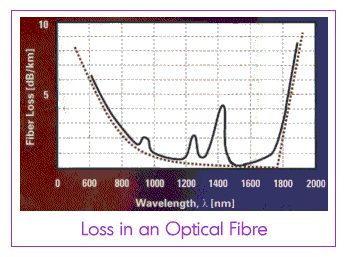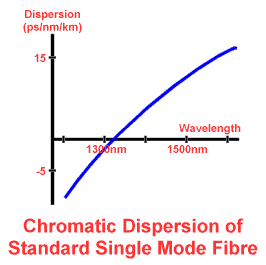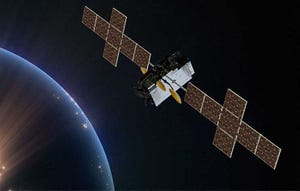Advanced Fiber Types
Optical fiber designed to work with, or in place of, conventional fiber in order to improve overall system performance
August 1, 2001

Before reading this you may find the following tutorials useful:
Optical Fiber, Nonlinear Effects, Chromatic Dispersion and Polarization Mode Dispersion (PMD), Erbium Doped-Fiber Amplifiers (EDFAs), Optical Units Reference"Conventional fiber" usually refers to the type of fiber discussed in the optical fiber tutorial. It will have attenuation as shown before, with the lowest loss available around 1550 nm. In terms of dispersion, the fiber will have zero chromatic dispersion around 1300 nm and a dispersion of around 15 ps/nm/km at the 1550 nm region.
In terms of dispersion, the fiber will have zero chromatic dispersion around 1300 nm and a dispersion of around 15 ps/nm/km at the 1550 nm region. Conventional fiber may also be referred to as standard fiber, standard singlemode fiber, unshifted fiber (the meaning of "unshifted" will become apparent later in this tutorial), and probably by any combination of such words. It served the optical networking industry very well in its early days, but as other technologies have advanced, so too has optical fiber.
Conventional fiber may also be referred to as standard fiber, standard singlemode fiber, unshifted fiber (the meaning of "unshifted" will become apparent later in this tutorial), and probably by any combination of such words. It served the optical networking industry very well in its early days, but as other technologies have advanced, so too has optical fiber.
Demands on optical fiber are greater than ever before, in terms of the number of wavelengths to be transmitted, the bit rate of each wavelength, and the distances involved. In order to optimize the performance of systems it can be necessary to replace conventional fiber with alternatives, or to use it together with other types in order to provide a specific system solution.
The subject of fiber manufacture is a combination of chemistry and physics – involving subtle changes to the chemical compositions and dimensions of the core and cladding to adjust their behavior. This tutorial will concentrate on what benefits the various new fiber types can provide in optical networks.
Dispersion Shifted Fiber (DSF)
Modern systems taking advantage of the low-loss 1550 nm region of optical fiber can be impaired by the high amount of chromatic dispersion at this wavelength in conventional fiber. Specifically, over long distances this situation could become critical and require the use of some dispersion compensation techniques. An alternative would be to use Dispersion Shifted Fiber (DSF), whose point of zero dispersion has been shifted to the 1550 nm region, thus removing this problem. This is achieved by altering the material dispersion component of the chromatic dispersion through adding additional dopants to the silica-based fiber material.
There will still be some dispersion at wavelengths either side of the zero dispersion point, but the amount will be considerably less than the 15 ps/nm/km or so experienced in conventional fiber. This will only become a problem over very long distances, in which case wavelengths could be used with a small negative dispersion (e.g., –1 ps/nm/km) that can then be cancelled out by short lengths of conventional fiber, which will provide positive dispersion to compensate. In this case, the conventional fiber has been used for dispersion compensation. This can take place at regular stages along the length of the system, or just by having the compensating fiber placed at the receiving terminal if the distances involved are not too long. The conventional fiber in this case pulls the pulses back together after the DSF has spread them apart in time.
Dispersion Compensating Fiber (DCF)
If conventional fiber is used to transmit in the 1550 nm region, then in a long span the large positive dispersion experienced will eventually need to be compensated. This function is performed by Dispersion Compensating Fiber (DCF), which is engineered to have a very highly negative dispersion at 1550 nm.
This could be on the order of –100 ps/nm/km, meaning that for every six or seven lengths of conventional fiber giving 15 ps/nm/km chromatic dispersion, one length of DCF would be required to bring the system back into line. This would have cancelled out the positive dispersion and brought the overall dispersion back to zero. The use of DCF, therefore, allows conventional fiber to still be used in the 1550 nm window even over long distances and at high bit rates.
There is a problem with "dispersion slope" however, in that each wavelength undergoes a slightly different dispersion, so the DCF will only fully correct at one particular wavelength. Care needs to be taken to ensure that the residual dispersion left behind by the DCF at other wavelengths is not enough to seriously impair the system performance.
Non-Zero Dispersion Shifted Fiber (NZ-DSF)
In DSF, there is zero dispersion around 1550 nm, which is desirable to avoid the high dispersion inherent in conventional fiber. However, in certain circumstances it can also be a disadvantage to have zero or very low dispersion, which is where Non-Zero Dispersion Shifted Fiber (NZ-DSF) comes into play.
The nonlinear effect "four-wave mixing" is where three different signal wavelengths in a system can interact to create a new signal at a different wavelength. This new signal takes power from the others and may also interfere with other signal wavelengths. The presence of some dispersion can discourage four-wave mixing from taking place (by reducing the possibility of "phase matching"), which is why NZ-DSF may be preferred over DSF if this nonlinear effect is expected to be an issue.
Large Effective Area Fiber
Nonlinear effects are caused by high optical powers in optical fiber. They are increasingly becoming a problem as more and more wavelengths are being used in systems, meaning that the total optical power is increasing. There is a way that these adverse nonlinear effects can be reduced, however.
It is the concentration of optical power in the fiber that promotes nonlinearities, so one way to reduce this is by having a larger area fiber in order the spread the power out. Large Effective Area Fiber promotes the transmission of the optical power through a greater area of the core and the cladding than in conventional fiber (up to 100 um2 compared with around 50 um2 in conventional fiber), thus reducing nonlinear effects. It will typically have a small non-zero dispersion in the 1550 nm window.
All Wavelength Fiber
An obvious limitation of conventional fiber is its higher attenuation either side of the 1550nm sweet spot – significantly higher around 1400 nm. To increase the capacity of systems it is an option to increase the number of wavelengths transmitted through the fiber. When all the wavelengths in the low-loss 1550 nm region have been used up it is natural to look to other wavelengths to meet the demand, which is where "all wavelength" fiber comes into play.
All wavelength fiber smoothes out the attenuation peak present in conventional fiber around 1400 nm, therefore opening up more possibilities for low-loss transmission wavelengths. In fact, the resulting loss at 1400 nm is less than that in the second transmission window at 1300 nm. This is primarily achieved by the removal of water during the manufacturing process, as it is the OH ions in conventional fiber that create the loss peak around 1400 nm.
Opening up a new transmission window does also create a few new problems, however, such as the need for components that will work in this new region. With regard to optical amplification, erbium-doped fiber amplifiers will only work in the 1550 nm region. However, the alternative in the 1400 nm window is a thulium-doped fiber amplifier, which is being heavily researched at present.
Key Points
Conventional fiber can be limited by its attenuation and dispersion properties
Dispersion Shifted Fiber (DSF) has zero dispersion around 1550 nm to help transmission at these wavelengths
Dispersion Compensating Fiber (DCF) has highly negative dispersion at 1550 nm to compensate for a buildup of positive dispersion in that region in conventional fiber
Non-Zero Dispersion Shifted Fiber (NZ-DSF) gives a small amount of dispersion in the 1550 nm region, which can reduce the effects of four-wave mixing
Large Effective Area Fiber allows the light to be transmitted in a larger total area of the fiber in order to reduce the concentration of high powers that may cause adverse nonlinear effects
All Wavelength Fiber removes the attenuation peak at 1400 nm to increase the range of possible wavelengths that can be transmitted at low loss
You May Also Like









